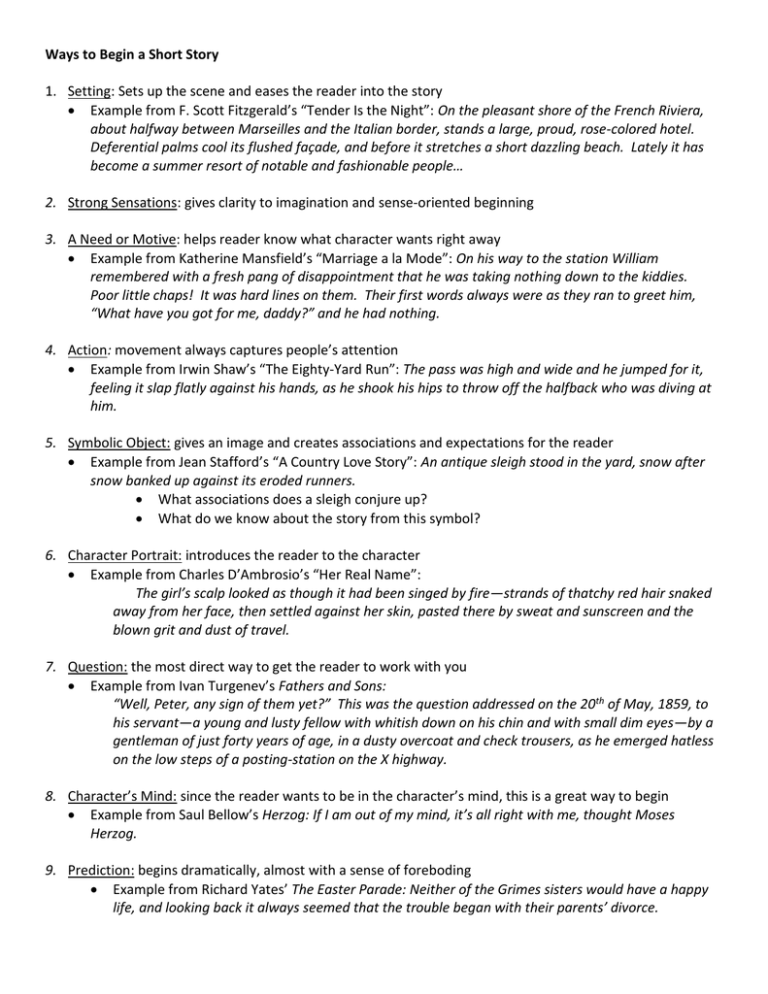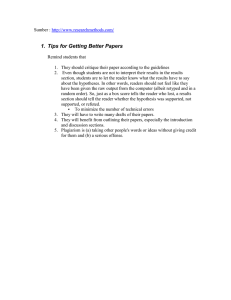Beginning A Short Story
advertisement

Ways to Begin a Short Story 1. Setting: Sets up the scene and eases the reader into the story Example from F. Scott Fitzgerald’s “Tender Is the Night”: On the pleasant shore of the French Riviera, about halfway between Marseilles and the Italian border, stands a large, proud, rose-colored hotel. Deferential palms cool its flushed façade, and before it stretches a short dazzling beach. Lately it has become a summer resort of notable and fashionable people… 2. Strong Sensations: gives clarity to imagination and sense-oriented beginning 3. A Need or Motive: helps reader know what character wants right away Example from Katherine Mansfield’s “Marriage a la Mode”: On his way to the station William remembered with a fresh pang of disappointment that he was taking nothing down to the kiddies. Poor little chaps! It was hard lines on them. Their first words always were as they ran to greet him, “What have you got for me, daddy?” and he had nothing. 4. Action: movement always captures people’s attention Example from Irwin Shaw’s “The Eighty-Yard Run”: The pass was high and wide and he jumped for it, feeling it slap flatly against his hands, as he shook his hips to throw off the halfback who was diving at him. 5. Symbolic Object: gives an image and creates associations and expectations for the reader Example from Jean Stafford’s “A Country Love Story”: An antique sleigh stood in the yard, snow after snow banked up against its eroded runners. What associations does a sleigh conjure up? What do we know about the story from this symbol? 6. Character Portrait: introduces the reader to the character Example from Charles D’Ambrosio’s “Her Real Name”: The girl’s scalp looked as though it had been singed by fire—strands of thatchy red hair snaked away from her face, then settled against her skin, pasted there by sweat and sunscreen and the blown grit and dust of travel. 7. Question: the most direct way to get the reader to work with you Example from Ivan Turgenev’s Fathers and Sons: “Well, Peter, any sign of them yet?” This was the question addressed on the 20th of May, 1859, to his servant—a young and lusty fellow with whitish down on his chin and with small dim eyes—by a gentleman of just forty years of age, in a dusty overcoat and check trousers, as he emerged hatless on the low steps of a posting-station on the X highway. 8. Character’s Mind: since the reader wants to be in the character’s mind, this is a great way to begin Example from Saul Bellow’s Herzog: If I am out of my mind, it’s all right with me, thought Moses Herzog. 9. Prediction: begins dramatically, almost with a sense of foreboding Example from Richard Yates’ The Easter Parade: Neither of the Grimes sisters would have a happy life, and looking back it always seemed that the trouble began with their parents’ divorce. Ways to Begin a Short Story 1. ___________: Sets up the scene and eases the reader into the story Example from F. Scott Fitzgerald’s “Tender Is the Night”: On the pleasant shore of the French Riviera, about halfway between Marseilles and the Italian border, stands a large, proud, rose-colored hotel. Deferential palms cool its flushed façade, and before it stretches a short dazzling beach. Lately it has become a summer resort of notable and fashionable people… 2. ________ ______________: gives clarity to imagination and sense-oriented beginning 3. __________ or__ __________: helps reader know what character wants right away Example from Katherine Mansfield’s “Marriage a la Mode”: On his way to the station William remembered with a fresh pang of disappointment that he was taking nothing down to the kiddies. Poor little chaps! It was hard lines on them. Their first words always were as they ran to greet him, “What have you got for me, daddy?” and he had nothing. 4. _______: movement always captures people’s attention Example from Irwin Shaw’s “The Eighty-Yard Run”: The pass was high and wide and he jumped for it, feeling it slap flatly against his hands, as he shook his hips to throw off the halfback who was diving at him. 5. ______________ _________: gives an image and creates associations and expectations for the reader Example from Jean Stafford’s “A Country Love Story”: An antique sleigh stood in the yard, snow after snow banked up against its eroded runners. 6. ____________ ____________: introduces the reader to the character Example from Charles D’Ambrosio’s “Her Real Name”: The girl’s scalp looked as though it had been singed by fire—strands of thatchy red hair snaked away from her face, then settled against her skin, pasted there by sweat and sunscreen and the blown grit and dust of travel. 7. ___________: the most direct way to get the reader to work with you Example from Ivan Turgenev’s Fathers and Sons: “Well, Peter, any sign of them yet?” This was the question addressed on the 20th of May, 1859, to his servant—a young and lusty fellow with whitish down on his chin and with small dim eyes—by a gentleman of just forty years of age, in a dusty overcoat and check trousers, as he emerged hatless on the low steps of a posting-station on the X highway. 8. ____________ ____________: since the reader wants to be in the character’s mind, this is a great way to begin Example from Saul Bellow’s Herzog: If I am out of my mind, it’s all right with me, thought Moses Herzog. 9. ____________: begins dramatically, almost with a sense of foreboding Example from Richard Yates’ The Easter Parade: Neither of the Grimes sisters would have a happy life, and looking back it always seemed that the trouble began with their parents’ divorce.



